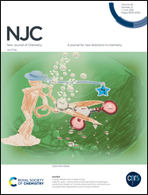Exploiting the role of stereoelectronic effects to design the antagonists of the human complement C3a receptor†
Abstract
Stereoelectronic effects are crucial in governing the conformational behaviour of small molecules bearing heterocyclic rings adjacent to amides. It dictates the antagonist and agonist activity for G-protein coupled receptor (C3aR) of inflammatory protein complement C3a on human macrophages. We have examined the role of non-covalent attractive interactions of heteroatoms of heterocycles adjacent to amides in the antagonists of C3a receptor (C3aR) using the CBS-QB3 and M06-2X/aug-cc-pVDZ levels of theory. The contribution of orbital interaction (n → σ* delocalization) towards the stability of antagonist has been examined and the systems were designed for the clear preference of such molecules to bind with C3aR protein. The molecular electrostatic potential (MESP) analysis also revealed the presence of Sigma-holes (σ-holes) in such systems interacting with the amide oxygen and contributed to the stability of the cis-conformation responsible for the antagonist behavior of such molecules. The –CF3 substituted electron-withdrawing group attached to the carbon atom of the –C–X bond enhanced the attractive non-covalent interaction between X(heterocycle) and O(amide) and electrostatic interactions that contribute to the stability of the cis-conformation of the antagonists. The –CF3 substituted selenazole ring (6Se-a) was stabilized by ∼4.0 kcal mol−1 than the other corresponding possible conformations. The non-covalent interaction (NCI) plot corroborates the non-covalent interactions between the heteroatoms in such molecules. The docking study performed with ligands L-1 and L-2 showed improved interaction with C3aR compared to those with the reported SB290157. Importantly, the cis-conformation of the ligands L-1 and L-2 persisted in the C3aR environment. The influence of the stereoelectronic effect on conformations of small ligands acting as antagonists towards G-protein coupled C3aR has been highlighted to design new candidates with better efficacy.



 Please wait while we load your content...
Please wait while we load your content...